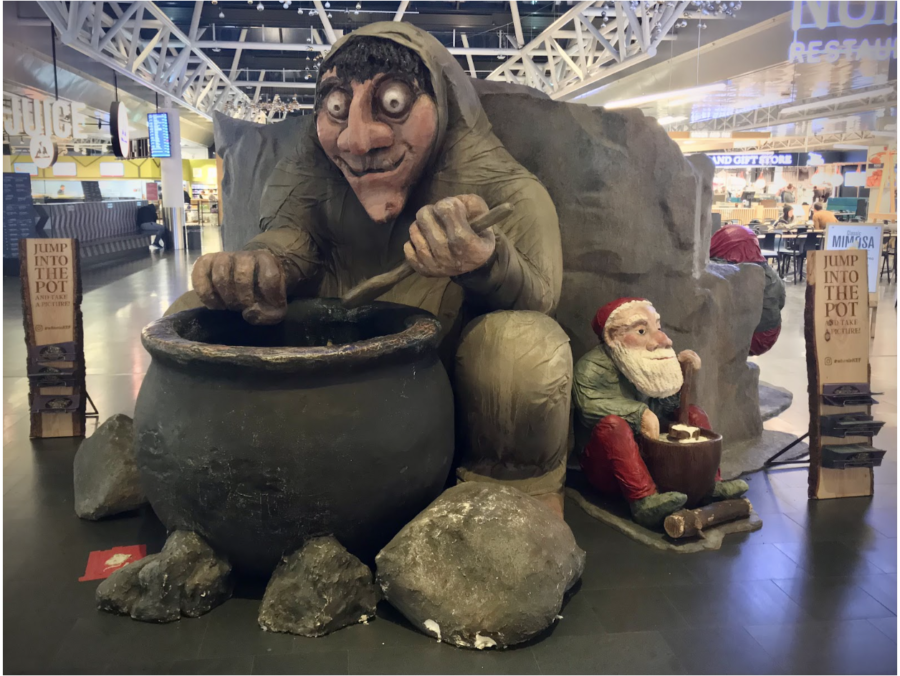The 13 Yule Lads: Icelandic troublemakers from the Holiday season
courtesy of WikiMedia Commons.
A giant statue of Pot-Scraper, the fifth Yule Lad.
Stockings are hung, the Christmas tree twinkles with lights while cookies and a cold glass of milk sit out on the table. The Elf on The Shelf quietly sits by waiting, not for Santa but for the 13 Yule Lads, Gryla, and the Christmas Cat. The poor elf evaded Krampus on the 5th of December, but what about the 12th through the 24th? Worse yet, what about Christmas Day?
Iceland is a Nordic country in Europe that’s relatively famous for its volcanoes, geysers, hot springs, and lava fields. These few examples of natural wonders don’t even express Iceland’s beauty, despite its chilly name.
While Europe is known for its outlandish creatures of the Holiday season -Germany with Krampus, Frau Perchta in Austria, parts of Germany, and Italy- Iceland takes the cake for the most compelling characters. The 13 Yule Lads, their mother Gryla, along with her Christmas Cat, are often used as metaphors for surviving some of the horrors that the much harsher Icelandic winter can bring.
The Yule Lads bring candy for the boys and girls that have been good, although, for the naughty children, these Lads put rotten potatoes in the kids’ shoes.
There are 13 in total one Yule Lad for each day starting the 12th and going until Christmas Eve, each has a different way of causing mischief, and while nowadays their tricks are seen as harmless, they were much more terrifying. So much so that in 1746 parents were officially banned from scaring their children with stories of those certain creatures.
While the Icelandic version of the Yule Lads’ names is challenging to understand, there are thankfully American versions derived from old poems and books highlighting the characters. The order goes as follows:
Stekkjastaur (Sheep Cote Clod) is the first of the Yule Lads. He goes around Iceland to harass the sheep of any household he came upon.
Giljaguar (Gully Gulk) is the second in the Yule Lad lineup. His form of troublemaking was to hide in gullies around the house, wait until the residents had fallen asleep, then break into the cowshed and steal any milk he could find.
Stufur (Stubby), the third Yule Lad, became a nuisance quickly throughout the Icelandic culture at Christmas by stealing any household pans for the crust and crumbs which remained.
Thvorusleikir (Spoon-Licker) is the fourth Lad, and guessing from the name one can probably tell what he does, he licks spoons. He’s malnourished due to him only licking spoons which is odd due to the fact that most troll-like beings are told to be overweight and muscular beings.
Pottaskefill (Pot-Scraper aka Pot-Licker), similar to Spoon-Licker, this fifth Yule Lad steals unwashed pots and licks them clean.
Askasleikir (Bowl-Licker) is the sixth Yule Lad who, believe it or not, licks bowls at night that hide under beds.
Hurdaskellir (Door-Slammer) is the seventh Yule Lad. His troublemaking antics were to slam doors as hard as he could and keep everyone in the house awake at night.
Skyrgamur (Skyr-Gobbler) makes number eight on the list of Lads and his job was to eat up all of the delicious Skyr that was left out. Skyr is a traditional Icelandic delicacy and resembles a yogurt-type dish.
Bjugnakraekir (Sausage-Snatcher) is number nine of the Yule Lads and he loves stolen sausages.
Gluggagaegir (Window-Peeper) is number 10 out of the 13 Yule Lads, he enjoys creeping outside windows and sometimes will steal some of the things he sees inside.
Gattathefur (Doorway Sniffer) is the 11th of the Lads. He uses his enormous nose and an equally enormous appetite to sniff out baked goods.
Ketkrokur (Meat-Hook) is the second to last of the Yule Lads, he waits under tables, and behind cabinets to steal meat with his cartoonishly big hook. Meat-Hook is very particular about the type of meat however, smoked lamb is his favorite.
Kertasnikir (Candle-Stealer) is the last of the Yule Lads. He emerges on Christmas Eve, although stealing candles may not be the worst crime, it kept the Icelandic people from their favorite past-time, reading.
Not only are these Yule Lads enough by themselves, but their mother and her cat are just as bad, if not worse. To learn more, continue reading the 2-part series.
Your donation will support the student journalists of Highlands High School. Your contribution will allow us to cover our annual website hosting costs.



